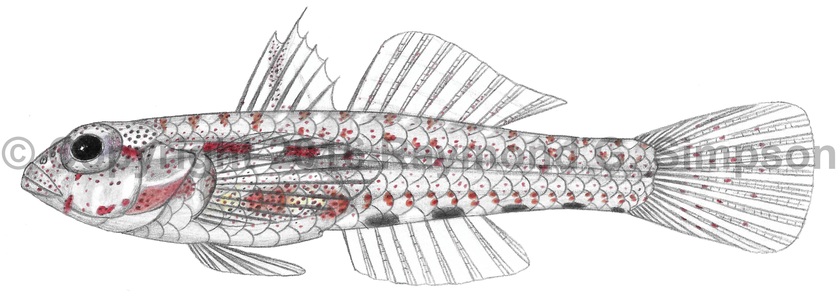
Common Name
Kuna Goby
Year Described
Victor, 2007
Identification
Dorsal Fin: VI; I, 8
Anal Fin: I, 8
Pectoral Fin: 14-15
Pelvic Fin: I, 5
Caudal Fin: 12 branched rays; 9+8 procurrent rays
Lateral Line Scales: 25
Vertebrae: 9+17=26
Body elongate. Snout profile straight. Eyes large and placed dorsally. A low fleshy ridge present on nape from between eyes to dorsal fin origin. Anterior nostril tubular. Posterior nostril not tubular. Mouth small. Tongue truncated. No teeth on vomer or palatine. Teeth in jaws present in several irregular rows. Gill membranes joined to isthmus. Pectoral, soft dorsal, and anal fins with all rays branched and bound by membranes (first element simple). Second dorsal base longer than caudal peduncle length. Ventral fins fused into disk with frenum absent, rays branched, and long innermost rays joined at rear. Body covered in ctenoid scales, becoming cycloid on chest. Head and nape naked. Head pores present (one between eyes and one pair between rear nostrils). No lateral line.
Color
Body translucent with opaque white blotches along side and around viscera and spinal column. Scattered burnt orange speckles and blotches over body. Darker speckles concentrated on and around orange blotches. Two larger orange blotches on anterior trunk over spinal column. A line of darker brown blotches on lower side form a line. Head with orange speckles and spots. Fins mostly clear with faint speckles. Eye with black spots on upper margin of eye.
Size
Maximum size to 25mm SL.
Habitat
Featureless sand flats from 10-25m. Not found on reefs.
Range
Western Caribbean Sea from Mexico to Panama.
References
Baldwin C.C. & D.R. Robertson. 2015. A new, mesophotic Coryphopterus goby (Teleostei, Gobiidae) from the southern Caribbean, with comments on relationships and depth distributions within the genus. ZooKeys 513: 123-142.
Victor, B.C. 2007. Coryphopterus kuna, a new goby (Perciformes: Gobiidae: Gobiinae) from the western Caribbean, with the identification of the late larval stage and an estimate of the pelagic larval duration. Zootaxa 1526: 51-61.